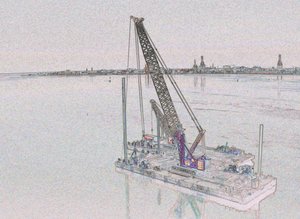The Bridge Blog
A dialog about our new bridge and these web pages
Overview. As a pointy-headed
university professor, my weekend project of bridge photography and
building these web pages generated many questions and introduced me
to just-in-time learning. I enjoy chasing my curiosity and
want to identify ways to encourage younger learners to also enjoy curiosity
chasing and learning.
Learning usually requires repetition while forgetting occurs when
I infrequently use information. Many young learners do not understand
the importance of repetition. Weekly visits to the bridge provided
the repetition necessary to detect changes in the bridge and
consequently generated
many questions and opportunities for learning. Over the course of the
bridge project, I had access to few experts for answering questions.
Rather than a liability, this became an asset and pushed me to improve
my search skills with Google. Soon, I found that answers
to questions encountered during my weekly photo shoots were often
only a Google-search away -
(see
Restoring the Joy in Learning). Consequently Google + Internet became
dependable extensions of my memory.
The bridge story is a work in progress and is evolving from a simple
collections of photographs to an experiment with Internet-centric
just-in-time learning.
Insights I gain from you
will find their way into the learning centers of MUSC.
Palmetto Bridge Constructors, a joint venture between
Tidewater
Skanska and
Flatiron Constructors, as well as
High Steel Structures,
Freyssinet, the
SCDOT and the
Federal Highway Commission Office
of Bridge Technology guided much of my learning.
I also learn from many of you and from Google-linked resources. More
important is the e-mail encouragement I receive from many of you.
Fri, 06 May 2005
May 6, 2005: Exploring digital sketches
 There comes a time when simply capturing the action of constructing the
new Cooper River Bridge approaches blindly following a recipe - and
I try to avoid falling into a rut. I have standard
places that I go, standard sets of photos that I take and standard ways
to process the images for placement in these web pages - all the ingredients
of a rut. Several weeks ago
I began experimenting with ways to alter the images so that they
took on the characteristics of a sketch. I cannot draw an attractive
stick figure, so for me, this was an opportunity to explore something that
I was totally incapable of doing on my own.
There comes a time when simply capturing the action of constructing the
new Cooper River Bridge approaches blindly following a recipe - and
I try to avoid falling into a rut. I have standard
places that I go, standard sets of photos that I take and standard ways
to process the images for placement in these web pages - all the ingredients
of a rut. Several weeks ago
I began experimenting with ways to alter the images so that they
took on the characteristics of a sketch. I cannot draw an attractive
stick figure, so for me, this was an opportunity to explore something that
I was totally incapable of doing on my own.
When I look at a sketch, I see the outlines of objects the artist projects.
So I started with processing an image with an edge detection algorithm. These
algorithms compute the difference in intensity of adjacent picture elements
(pixels). When the intensity difference is small, then the point appears
black. When the intensity is large, then the point appears white.
Consequently edges (where there is a large intensity difference) will appear
as while lines. But an artist sketches with a black pencil, so I inverted
the image - white became black and black became white. Because these
are color images, edges are computed for each of the three colors - red,
green and blue. I then alter the black-white range of intensities
so that I get a more balanced image. The results, as seen here, are
interesting. Bibi, an art history student at UC Berkeley and friend of our
family finds that these transformations bring something new to the art
table - an improvement beyond simply copying an artistic style.
posted at: 05:45 | path: | permanent link to this entry